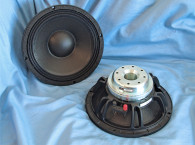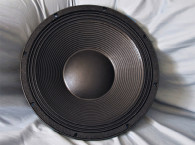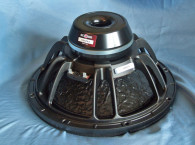
The B&C 21DS115-8 (see Photo 1) is designated as a woofer/subwoofer and is a rather high power handling woofer rated at 1,700 WRMS (a two-hour test was made with a continuous pink noise signal with a 6 dB crest factor within the range Fs-10 Fs and the power calculated on the rated minimum impedance with the loudspeaker in free air) with a continuous power handling rated at 3,400 WRMS (power on continuous program is defined as 3 dB greater than the nominal rating). The 21DS115-8 weighs in at a modest (for an 21” woofer!) 32.8 lb. The 21DS115-8’s feature set includes a proprietary 12-spoke cast-aluminum frame (six dual spokes) that has six 55 mm × 6 mm vents below the spider mounting shelf, with additional cooling provided by eight 8 mm diameter peripheral vents and a 40 mm diameter pole vent with a flared exhaust.
The cone assembly consists of a 21” curvilinear pulp paper cone and a large 7.5” diameter paper dust cap, both coated with a TWP waterproof coating (both sides on the cone). Suspension is provided by a three-roll M-shaped coated (sealed) cloth surround in conjunction with two 7” diameter flat silicone-treated cloth spiders (dampers), which I would assume are mounted back-to-back to cancel out odd-order nonlinearity. All this is driven by a 4.5” (116 mm) diameter high-temperature nonconducting glass fiber voice coil former wound with a round aluminum wire winding and terminated to a double set of solderable terminals. Magnetic drive is provided by a neodymium inside slug and a T-pole piece, and incorporates an aluminum demodulating ring (i.e., shorting ring or Faraday shield). Overall, the 21DS115-8’s build quality is excellent.
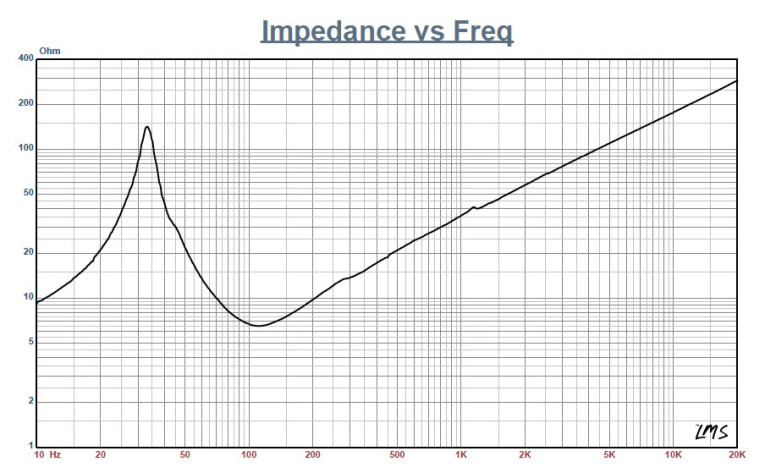

I began testing for the 21DS115-8 using the LinearX LMS and VIBox to produce voltage and admittance (current) curves. The driver was clamped to a rigid test fixture in free-air at 1, 3, 6, 10, 15, 20, 30, and 40 V. Also, please note I use a procedure that attempts to achieve the third-time constant on each sweep, such that the LMS oscillator is turned on for a progressively increasing time period between sweeps. Following the established Test Bench test protocol, I no longer use a single added mass measurement. Instead, I use the actual measured cone assembly weight, which was provided by B&C Speakers, at my request. I should also note that this driver stayed very linear up to 40 V. I would have needed to drive it probably up to 60 V to start riding out of the gap, but it’s difficult to be in the same room at that voltage level!
Next, I post-processed the 16 550-point stepped sine wave sweeps for each sample and divided the voltage curves by the current curves to derive impedance curves. These were phase calculated (LMS is a single channel analyzer and does not measure phase, but does have a highly accurate proprietary phase calculation methodology) and along with the accompanying voltage curves, imported to the LEAP 5 Enclosure Shop software. Obviously, this is a more time-consuming process than the usual low voltage small-signal impedance curve technique used for deriving Thiele-Small (T-S) parameters. The reason for this, is that the LEAP 5 LTD transducer model methodology results in a more accurate prediction of excursion at high voltage levels, which is one of the real fortes of the LEAP 5 software used in conjunction with the VIBox.
Because most T-S data provided by OEM manufacturers is produced using either a standard modeling method or the older LEAP 4 TSL model, I additionally created a LEAP 4 TSL model using the 1 V free-air curves. I selected the complete data set, the multiple voltage impedance curves for the LTD model, and the 1 V impedance curves for the TSL model in LEAP 5’s Transducer Derivation menu and created the parameters for the computer enclosure simulations.
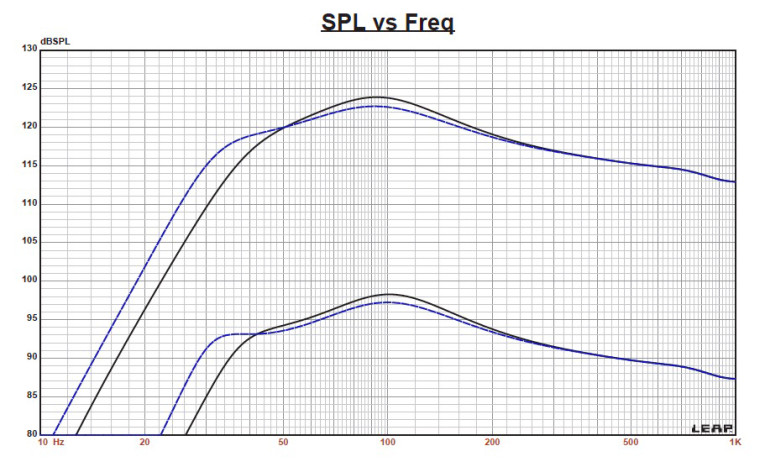


Figure 1 shows the 1 V free-air impedance curve. Table 1 compares the LEAP 5 LTD and TSL data and factory parameters for both 21DS115-8 samples. Comparing my results against the factory numbers shows a fairly good correlation. I am not certain about the published XMAX number, as the gap height is 11 mm* (see Note at the end of article) and the winding length is 36 mm, which is a physical XMAX of 11 mm, so the 15 mm XMAX listed in the B&C Speakers’ datasheet is likely a misprint since no secondary criteria was given. Given this, I used the LEAP LTD parameters for Sample 1 to set up two computer enclosure simulations using the box volumes and tuning recommended by B&C Speakers.
Given this, I programmed the first vented alignment as a 4.6-ft3 Extended Bass Shelf (EBS) box alignment with 15% fiberglass fill material tuned to 40 Hz with a 6” diameter vent tube. The second one was a 8.8-ft3 vented box with 15% fill material, tuned to 32 Hz.
Figure 2 illustrates the enclosure simulation results for the 21DX115-8 in the EBS vented box and the larger vented enclosure at 2.83 V and at a voltage level sufficiently high enough to increase cone excursion to 12.7 mm (XMAX + 15%). This produced a -3 dB frequency of 35.7 Hz (-6 dB = 32.4 Hz) for the 4.59-ft3 EBS enclosure and F3 = 28.8 Hz (F6 = 26.5 Hz) for the 8.8-ft3 ported box simulation. Increasing the voltage input to the simulations until the maximum linear cone excursion was reached resulted in 124 dB at 60 V for the EBS enclosure simulation and 123 dB for the same 60 V input level for larger vented box.
Figure 3 and Figure 4 show the 2.83 V group delay curves and the 60 V excursion curves, respectively. Note that both simulations excursion curves only exceed XMAX +15% below 20 Hz, which is where I cut off the voltage increase. As with all vented speakers, a steep high-pass filter in the 20-Hz region would increase the output of this speaker.

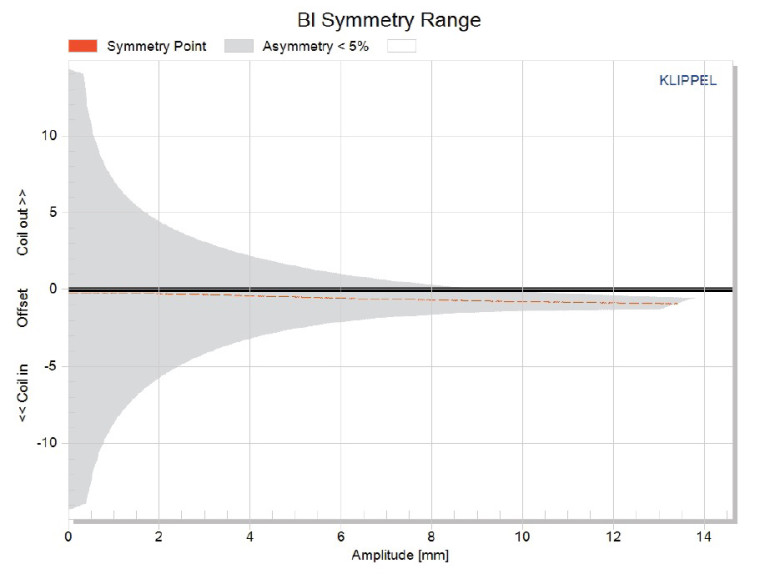
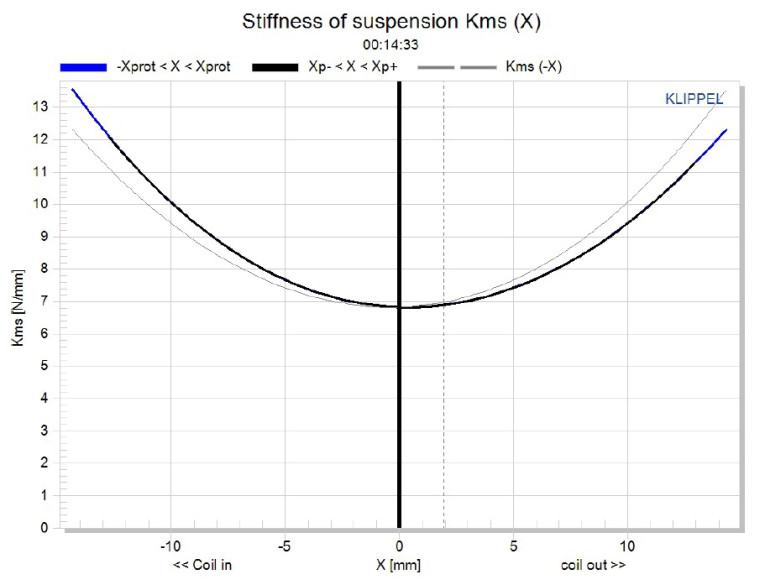
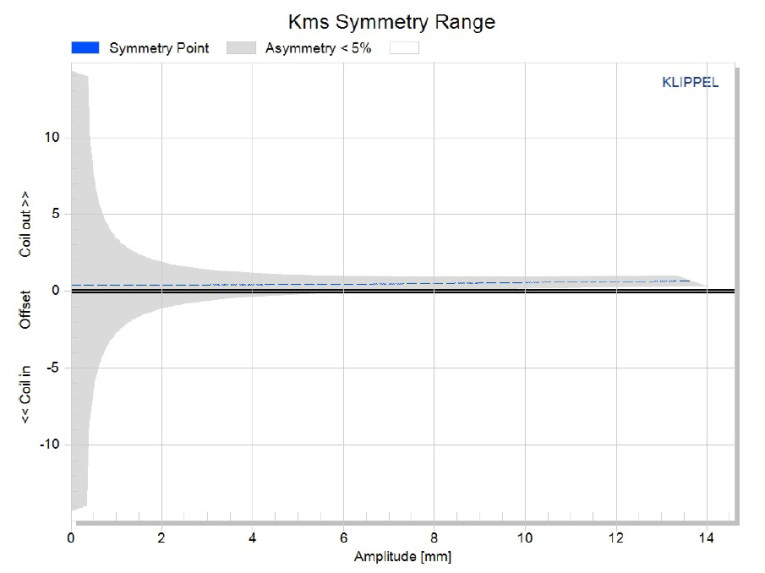
Klippel analysis for the 21DS115-8 produced the Bl(X), KMS(X), and Bl and KMS symmetry range plots shown in Figures 5–8. Our analyzer is provided courtesy of Klippel GmbH with testing performed by Patrick Turnmire, of Redrock Acoustics (author of the SpeaD and RevSpeaD transducer software).
Figure 5 shows the 21DX115-8’s Bl(X) curve is nicely broad and very symmetrical. Looking at the Bl symmetry plot shown in Figure 6, we find less than 1 mm coil-in offset at 6 mm excursion (where the grey uncertainty curve starts to diminish) and remains nearly constant out to beyond the driver’s physical XMAX, which is about as good as it gets.
Figure 7 depicts the KMS(X) and KMS symmetry range curves. The KMS(X) curve is as also very symmetrical, and with a small amount forward coil-out offset (less than 1 mm) beginning at 6 mm and greater excursion. The KMS symmetry range curve shows the forward offset is only 0.20 mm at the driver’s physical XMAX, which is negligible. Really, this is picture-perfect Klippel data!
Displacement limiting numbers calculated by the Klippel analyzer for the 21DS115-8 were XBl at 70% (Bl decreasing to 70% of its maximum value) was greater than 12.7 mm (1.7 mm greater than the physical XMAX) and for crossover (XC) at 50% (compliance decreasing to 50% of its maximum value) was also greater than 12.7 mm (also well beyond the 21DS115’s physical XMAX), which means both Bl and compliance contribute equally as the limiting factor for prescribed distortion level of 20% (the criteria for subwoofers).

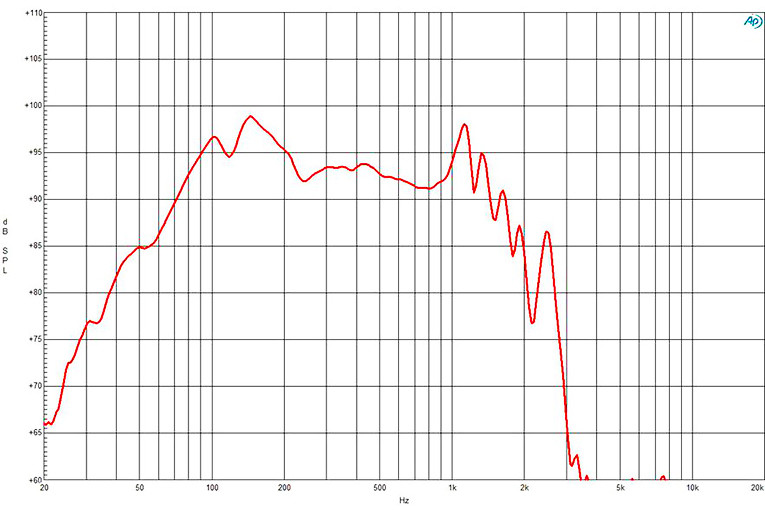

Figure 9 gives the inductance curve L(X). Inductance will typically increase in the rear direction from the zero rest position as the voice coil covers more pole area, or in this case, the return cup unless the driver incorporates a shorting ring, which this driver does. The 21DS115-8’s inductive swing from rest to the coil-in XMAX position is about 0.33 mH and from rest to the coil-out XMAX position is 0.31 mH, which is excellent inductive behavior.
I did not do SPL or time-frequency measurements for the 21DS115-8, mostly because I don’t keep 18” or 21” size cabinets in my inventory of test boxes. However, Figure 10 shows the factory SPL curve. Next, I moved on to the distortion test, which was performed using the Listen AmpConnect analyzer, SC-1 microphone, and SoundCheck 14 software (courtesy of Listen, Inc.).
Setting up for the distortion measurement consisted of mounting the woofer rigidly in free-air and setting the SPL to 104 dB at 1 m using a noise stimulus (SoundCheck has a software generator and SPL meter as two of its utilities) to establish the required voltage (6.9 V for the 21DS115). Then, I measured the distortion with the Listen microphone placed 10 cm from the dust cap. This produced the distortion curves shown in Figure 11.
The number of high-performance pro sound driver manufacturers in Italy never ceases to amaze me. If you consider B&C Speakers, Faital Pro, LaVoce, and Ciare/18 Sound, you have some very solid brand names that all produce extremely well-engineered and high-quality pro sound drivers, which is impressive. As for the 21DS115, the data speaks for itself. This is another well-engineered product from B&C Speakers!
www.bcspeakers.com
This article was originally published in Voice Coil, August 2016.
* Note: The XMAX listed on the B&C Speakers spec sheet for the 21DS115 had a misprint with an incorrect gap height at 11 mm. The actual gap height for this driver is 14 mm, which would result in XMAX = 11 mm. Actually, B&C Speakers usually quotes XVAR, which it calculates as XMAX + 25% of the gap height (Hvc-Hg)/2 + HG/4, which in this case would be 14.75 mm. I basically do a similar thing by looking at XMAX +15% for maximum excursion.




